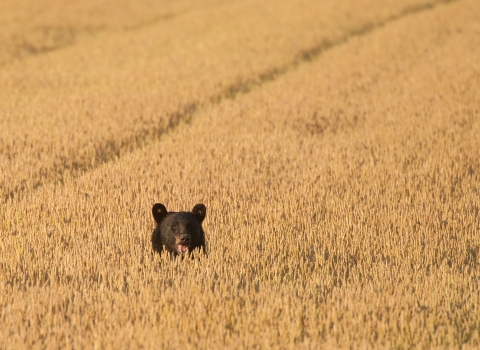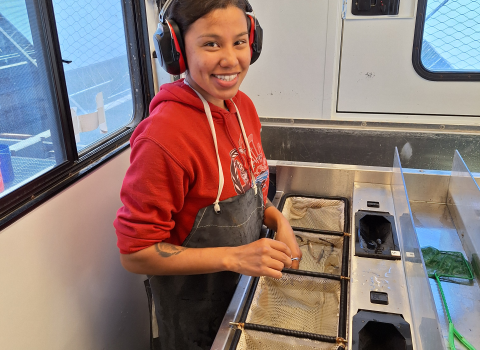Salmon. What do they mean to us? What significance do they have in the ecosystem? What role do they play in Native American cultures?
Salmon have been around for millions of years, making their incredible journey to and from the ocean, often traveling thousands of miles in their short lifetime. To people in salmon country, the connection to these fish is larger than simply fishing, catching, and harvest; they represent a deeper connection to the land and water that both fish and humans share.
These fish were once much more abundant, sustaining entire Native American populations on the Pacific Coast from present-day Mexico to Alaska. Native people travelled hundreds of miles—from as far as the Great Plains or even further east--to gather at Celilo Falls near present day The Dalles, Oregon, to fish and trade. Salmon were the draw. First fish ceremonies, which celebrate the return of spring Chinook salmon, continue today, giving thanks for the fish that has sustained their culture since time immemorial.
Salmon are an icon of the Pacific Northwest. Five species grace our waterways: Chinook, coho, pink, chum, and sockeye. Each is uniquely adapted to different river systems and watersheds. Pacific salmon are anadromous: they spend the first years of their life in freshwater, migrate to the ocean where food is more abundant, and then return as adults to the same streams where they were born to spawn and die. This unique life history evolved over millions of years and has spanned multiple ice ages.
As a result, salmon have developed truly remarkable behaviors and physiological traits. Some salmon travel as far as 600 miles—each way-- in their journeys from freshwater to the ocean and back. They change their body chemistry each time they migrate, adapting and then re-adapting their endocrine systems to breathe oxygen first in freshwater, then saltwater, then freshwater again. Young salmon (fry) memorize the unique water chemistry of the rivers, streams, or lakes where they are born. As returning adults they use that imprinted memory to ‘home’ to their natal streams. Western rivers and streams have high gradients, so some salmon can leap waterfalls up to eight feet high. When they spawn, they dig nests (redds) dug in cobble with their tails that can contain, depending on the species, 1,000-7,000 eggs.
Not only do returning salmon start a new generation of fish, they sustain more than 100 other species by returning essential ocean nutrients to the streams where they die. These nutrients are used by the new life created in the redds, stream and riparian riparian
Definition of riparian habitat or riparian areas.
Learn more about riparian vegetation, and other organisms living in and around the stream. Salmon are considered a keystone species, meaning other species depend on them for their survival. When salmon are removed from the ecosystem, it changes dramatically.
Salmon are vitally important to different user groups. Native Americans have a natural, annual rhythm: harvest, celebrate, give thanks, respect, repeat. There is a balance. Commercial fishermen seek salmon to sustain a livelihood, many with small operations in towns along the Washington and Oregon coasts. Sport fishing is a rite of passage for many: whether it is from your own boat, with a guide, or from the bank. Who can resist the story of pulling in that fish? Or relaying a story where the salmon grows with each telling?
Lewis and Clark documented an abundance of salmon on their expedition in 1805 and 1806. Historical records indicate 16 million to 20 million salmon would return up the Columbia River annually. By the 1860s salmon harvest and canneries, were in full production. Over the next 20 years some 55 canneries would be operating in the lower Columbia River. Fishing pressure and concerns about overfishing prompted the start of artificial production in the region. The Clackamas Hatchery was established on the Clackamas River in 1878 by cannery workers; this hatchery would later be run by the U.S. Fish Commission, which would later become the U.S. Fish and Wildlife Service.
Through the 19th and 20th centuries salmon populations declined; first from overfishing, followed by the northwest timber industry harvesting vast sections of land, which negatively impacted salmon habitat in rivers and streams. As more people moved to the Pacific Northwest, the effects of agriculture hit hard at the turn of the century. Newly constructed dams, such as Rock Island Dam in 1933, followed by Bonneville Dam in 1938, allowed vast amounts of water to be pulled from the Columbia River and its tributaries. Hundreds more dams would be completed in the following decades, nearly all impeded salmon migration. While the salmon adapted to these human impacts, hatcheries became the solution to make up for lost habitat.
The first federal hatchery in the lower Columbia basin was Little White Salmon National Fish Hatchery, established in
1896; soon followed by Spring Creek National Fish Hatchery in 1901. An abundance of unique, cold water sources across the Pacific Northwest made producing millions of salmon to supplement declining runs possible. Federal, state, and Tribal hatcheries were built throughout the region, making more fish. Over the next seven decades, four additional National Fish Hatcheries—Willard (1951), Carson (1938), Eagle Creek (1956), and Warm Springs (1978)--would be established in what today is the Columbia River Gorge National Fish Hatchery Complex within the larger National Fish Hatchery System network. They are part of a coast-to-coast network of 70 facilities found in 42 states producing a wide variety of locally significant species.
The initial mission of hatcheries in the Pacific Northwest was to produce as many fish as possible. Over time, fisheries management goals and hatchery programs evolved as concerns over declining salmon populations increased. Federal courts in the 1970s began upholding Tribal treaty rights and requiring equitable salmon harvest levels. In the 1980s and 1990s, the United States signed bilateral agreements with Canada to protect salmon populations and promote sustainable fisheries. Continued threats to salmon populations escalated, triggering Endangered Species Act protections for vulnerable wild populations in the Pacific Northwest and California.
Around 1 million to 2 million salmon now return to the Columbia Basin annually; of those, a majority are hatchery fish. Hatchery managers combine historic fish culture techniques with cutting-edge technologies in a world made increasingly complicated by human population growth, climate change climate change
Climate change includes both global warming driven by human-induced emissions of greenhouse gases and the resulting large-scale shifts in weather patterns. Though there have been previous periods of climatic change, since the mid-20th century humans have had an unprecedented impact on Earth's climate system and caused change on a global scale.
Learn more about climate change , and requirements to recover, and not harm, wild fish populations.
Today, hatcheries are funded by many different sources, and fulfill multiple missions and needs. All user groups want salmon: Tribes and Tribal members (who are entitled to them through treaties and court rulings) for subsistence, commerce, and ceremony; non-Tribal commercial anglers sustaining a livelihood and providing for families; and sport anglers looking to catch that big one, getting their piece of the Pacific Northwest icon.




